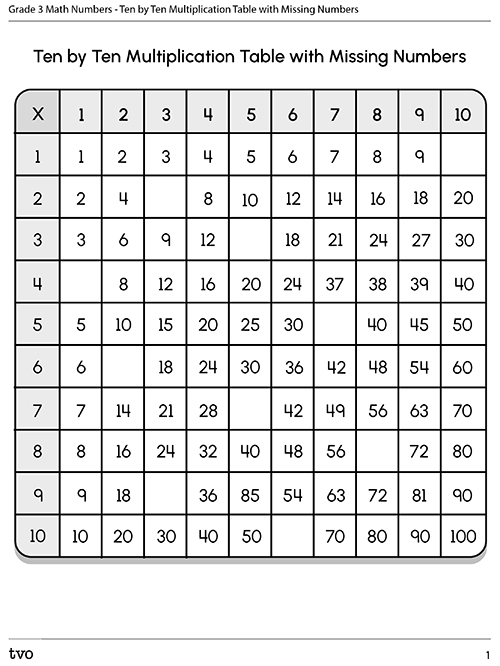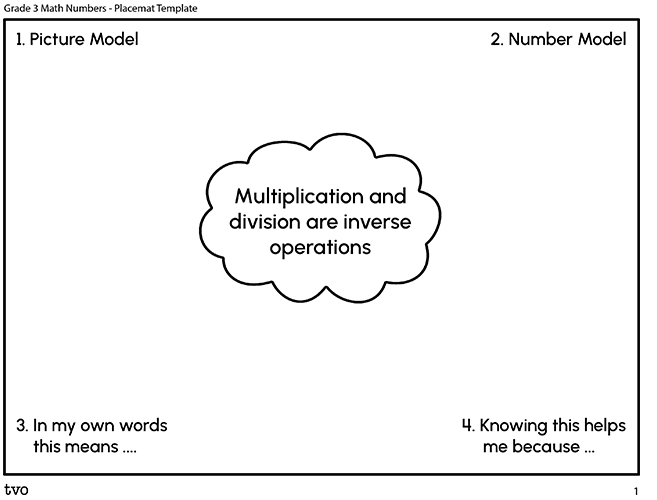Minds On
Finding missing tens
Student Success
Think-Pair-Share
What do you remember about multiplying tens?
Fill in the missing values in this Ten by Ten Multiplication Table with Missing Numbers.

Press the Activity button to access Ten by Ten Multiplication Table with Missing Numbers.
Activity (Open PDF in a new tab)What strategies did you use to fill in the missing values?
Using words, explain in a set of steps how you would use the multiplication table to solve:
4 × 8 =
9 × 3 =
Could you use the multiplication table to solve a division question? Why or why not? Explain using an example.
Note to teachers: See your teacher guide for collaboration tools, ideas and suggestions.
Multiplication strategies
There are many different strategies to use when solving multiplication and division problems. Let’s explore some of the strategies.
Repeated addition and repeated subtraction
We can use repeated addition to represent and solve a multiplication problem and repeated subtraction to represent and solve a division problem. Perhaps you used this strategy when you filled in the missing values in the multiplication chart.
Repeated addition or subtraction occurs when you add or subtract by the same number. Another name for repeated addition or repeated subtraction is skip counting.
Arrays
We can use arrays to represent and solve multiplication and division problems. Did you draw pictures to help find the missing values in the multiplication chart?
An array is a set that shows equal groups in rows and columns. Arrays help us identify equal groups and solve multiplication and division problems.
Number lines
We can use number lines to represent and solve multiplication and division problems.
We can model repeated jumps, or skips, on a number line to represent and solve multiplication and division problems. The jumps or skips represent the equal groups in the situation.

In this learning activity, we will learn to represent and solve multiplication and division situations.
Action
When to multiply and when to divide
Multiplication and division are both used to represent situations that involve repeated groups of equal size. An important part of problem solving is knowing when to use multiplication and when to use division.
When we read word problems, there are key words to help us decide which operations to use to solve.
Student Success
Think-Pair-Share
Multiply or divide?
Solve each problem. Include in your solutions the key words and other information that helped you decide which operation to use. Share your thinking in your notebook.
Problem # 1: Mr. Spurn had 70 pieces of paper, and Mr. Spurn made bundles by stapling an equal group of 10 pieces of paper together. How many bundles could Mr. Spurn make?
Problem # 2: There were 5 pirates on the green ship. There were 3 times more pirates on the blue ship. How many pirates were on the blue ship?
Share your work in your notebook.
Reflection: Do you think it is possible to solve the questions using multiplication and division? Share your ideas in your notebook.
Note to teachers: See your teacher guide for collaboration tools, ideas and suggestions.
Multiplication and division: Opposite operations
Multiplication and division are opposite operations. We call multiplication and division inverse operations.
When we multiply, we know the size of the group and the number of groups. We multiply to find the total.
When we divide, there are two types of questions we can solve:
Equal Grouping: We know the size of the group and the total. We divide to find the number of groups.
OR
Equal Sharing: We know the number of groups and the total. We divide to find the size of the group.
These are multiplication sentences that show numbers that are in the same "fact family". In Math, a "fact family" is a group of math facts (or 'equations') made using the same numbers.
Student Success
Think-Pair-Share
We can use fact families to show the relationship between multiplication and division. Fact families help to solve multiplication and division problems.
Practice
Solve this problem. When you have found your solution, create a fact family for the 3 numbers in the question and answer.
Sasha’s class is going canoeing. There are 27 students and 9 canoes. How many students will be in each canoe?
Use a variety of representations to justify your answer. Use math language to describe the strategies you used to solve the problem.
Create a fact family using the 3 numbers. How can a fact family help to solve multiplication and division problems?
What type of question is this division problem: Equal Sharing or Equal Grouping? How do you know?
Share your work and ideas in your notebook.
Note to teachers: See your teacher guide for collaboration tools, ideas and suggestions.
Multiplying and dividing with fractions
When we multiply, we combine equal groups and when we divide we decompose a whole into equal groups. We can multiply and divide whole numbers and fractions.
We can use the same tools and strategies to represent and solve multiplication and division problems involving fractions that we use with whole numbers.
Riley was given 5 halves of a sandwich. How many sandwiches does he have? In your number sentence, circle each instance of + to indicate a whole.
Solution using repeated addition
Let’s use repeated addition to represent and solve the problem.
I know that Jasper has eaten of a sandwich. I know that Riley has eaten 5 times as much. Times is a key word to represent multiplication. I know I have to multiply to solve.
I can use repeated addition to solve. I know I have to add five times.
+ + + + + =
When I add the s together my answer is I know this means that there are 5 parts but the whole is 2 parts. That means that there are 2 parts = 1 whole.
Since there are 5 parts, I know Riley ate 2 whole sandwiches and of another sandwich.
Jazmine eats half of a banana everyday for a snack. Jazmine has 3 bananas. How many snacks can Jazmine have?
Again circle two halves to show one banana.

Solution using a number line
I know that Jazmine runs km every day. I know that Jazmine is training to run 1 km. I see that Jazmine is running the same amount each day and the question is asking “how many days will it take to run the full 1 km?”
This looks like a division question where I know the size of the group and the total, but I have to find the number of groups. This is an equal grouping division question.
I can solve using a number line. My number line represents groups. How many groups of can make to total 1 whole?

I have jumped 4 times to represent 4 groups of one fourth. I know that it will take 4 days for Jazmine to run 1 km if she runs each day.
Student Success
Think-Pair-Share
Practice with Peter Piper
Solve this problem. Use a variety of representations to show your thinking.
Peter Piper picked of a basket of peppers each day. How many baskets of peppers will Peter Piper have picked after 4 days? After 7 days?
Share your work in your notebook. Include in your thinking answers to the following reflections:
What strategies or tools did you use to solve the problem?
How did you know which operation to use in your solution?
Note to teachers: See your teacher guide for collaboration tools, ideas and suggestions.
Consolidation
Challenge
Solve the following problem using tools and strategies you have learned in this lesson.
Question
Priva handed out 24 markers equally to 8 tables of students in her class. Mathias handed out 20 markers equally to 4 tables of students in his class. Which class will have more markers at each table?

Is this solution correct?
Here is one solution. Priva’s class will have more markers at each table because Priva’s class has 24 markers and Mathias’ class has 20 markers. Since 24 is greater than 20, Priva’s class will have more markers at the tables. Is this solution correct? Use a variety of representations to show your thinking.
Student Success
Think-Pair-Share
Placemat poster
Create a placemat poster to demonstrate the inverse relationship between multiplication and division. Use the template to create your poster. Make sure to share your understanding of the relationship between multiplication and division.
Complete the Placemat Template in your notebook or using the following fillable and printable document.
Note to teachers: See your teacher guide for collaboration tools, ideas and suggestions.
Reflection
How do you feel about what you have learned in this activity? Which of the next four sentences best matches how you are feeling about your learning? Press the button that is beside this sentence.
I feel…
Now, record your ideas about your feelings using a voice recorder, speech-to-text, or writing tool.
